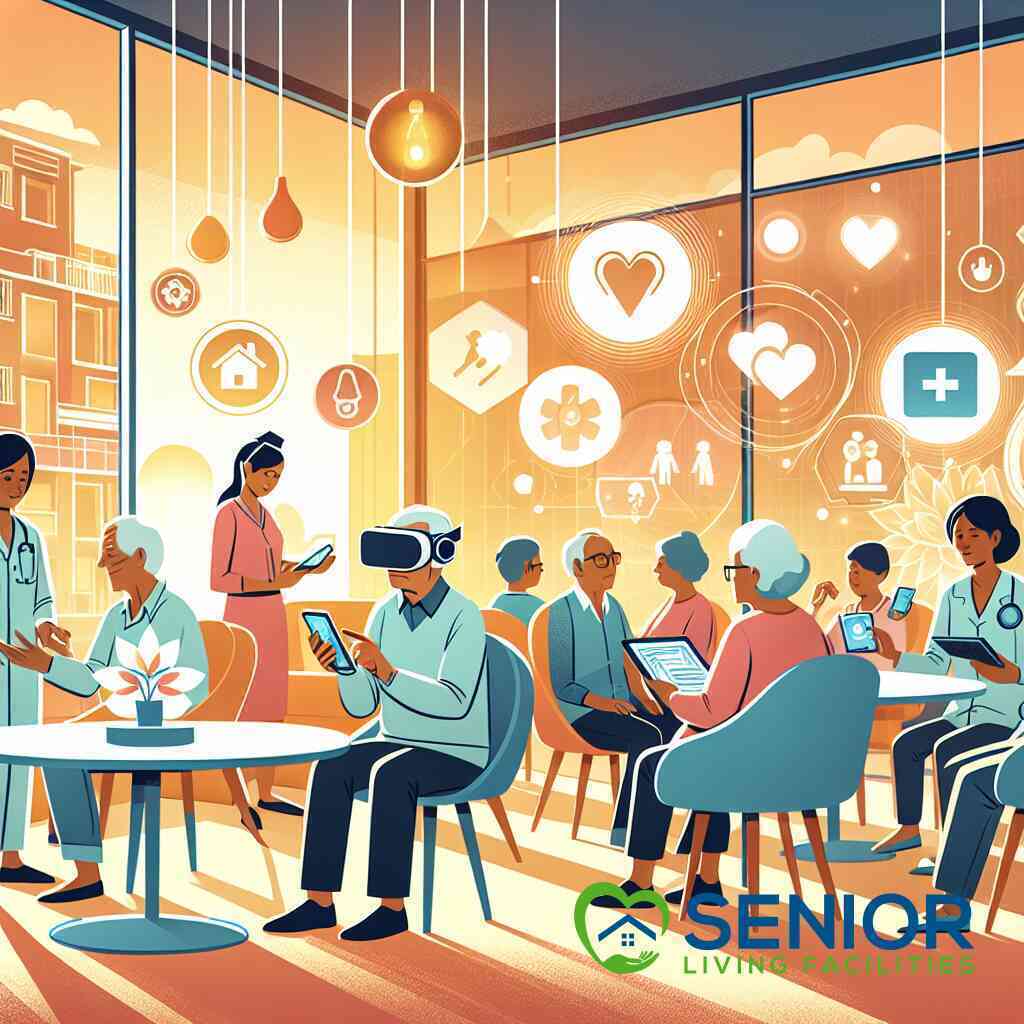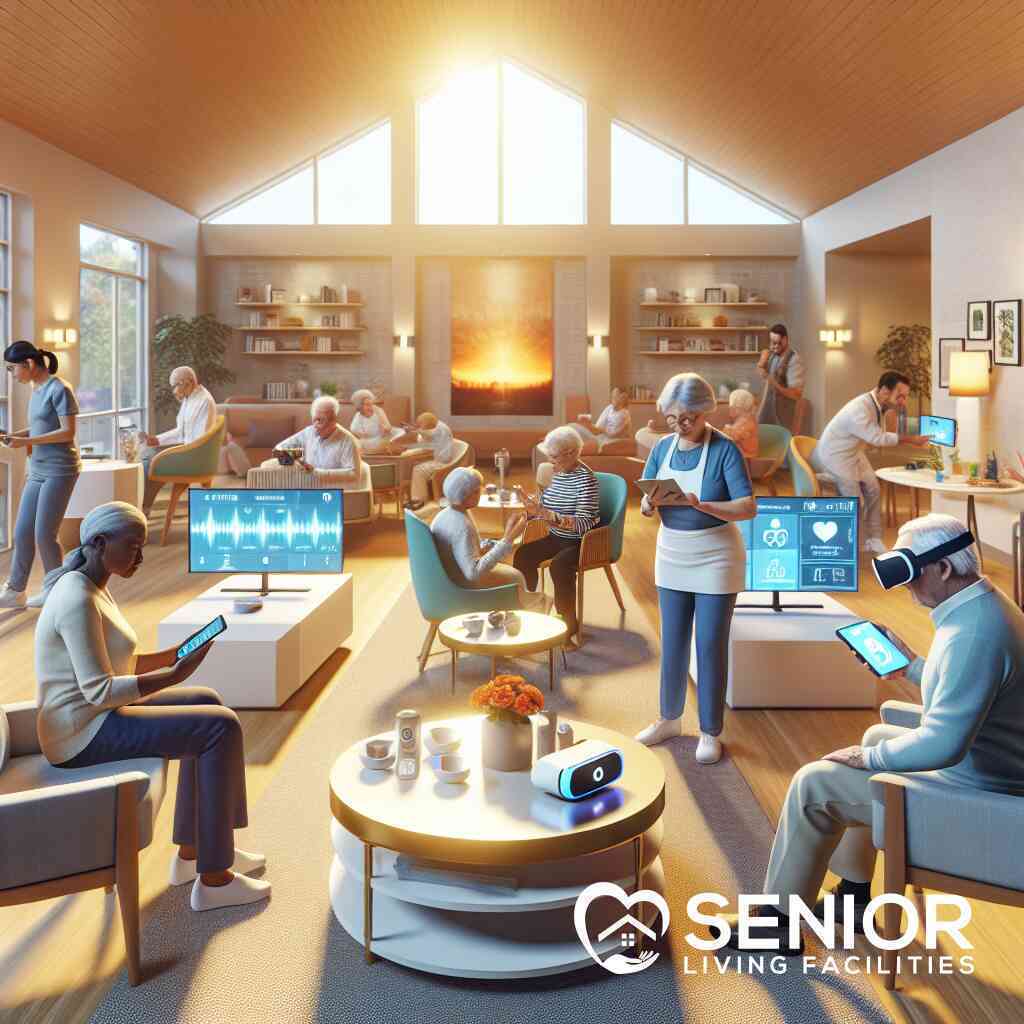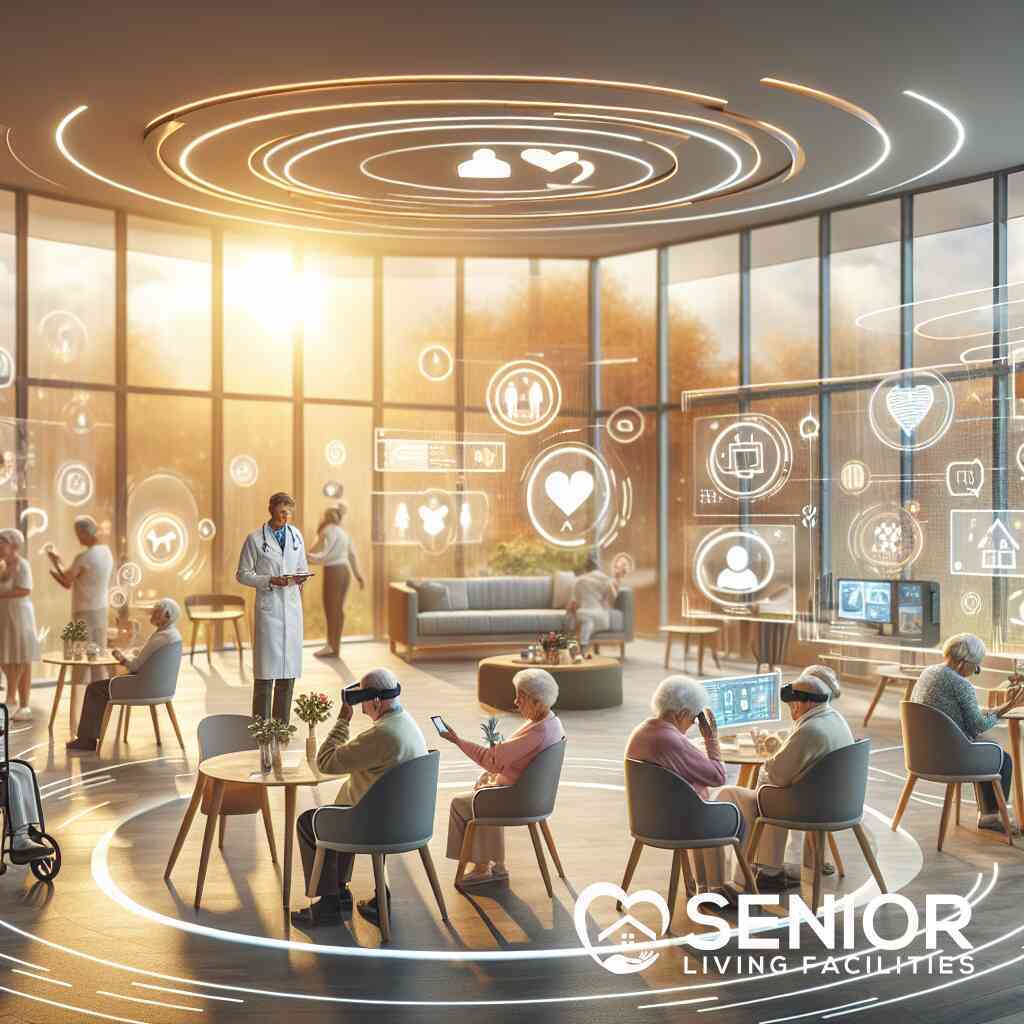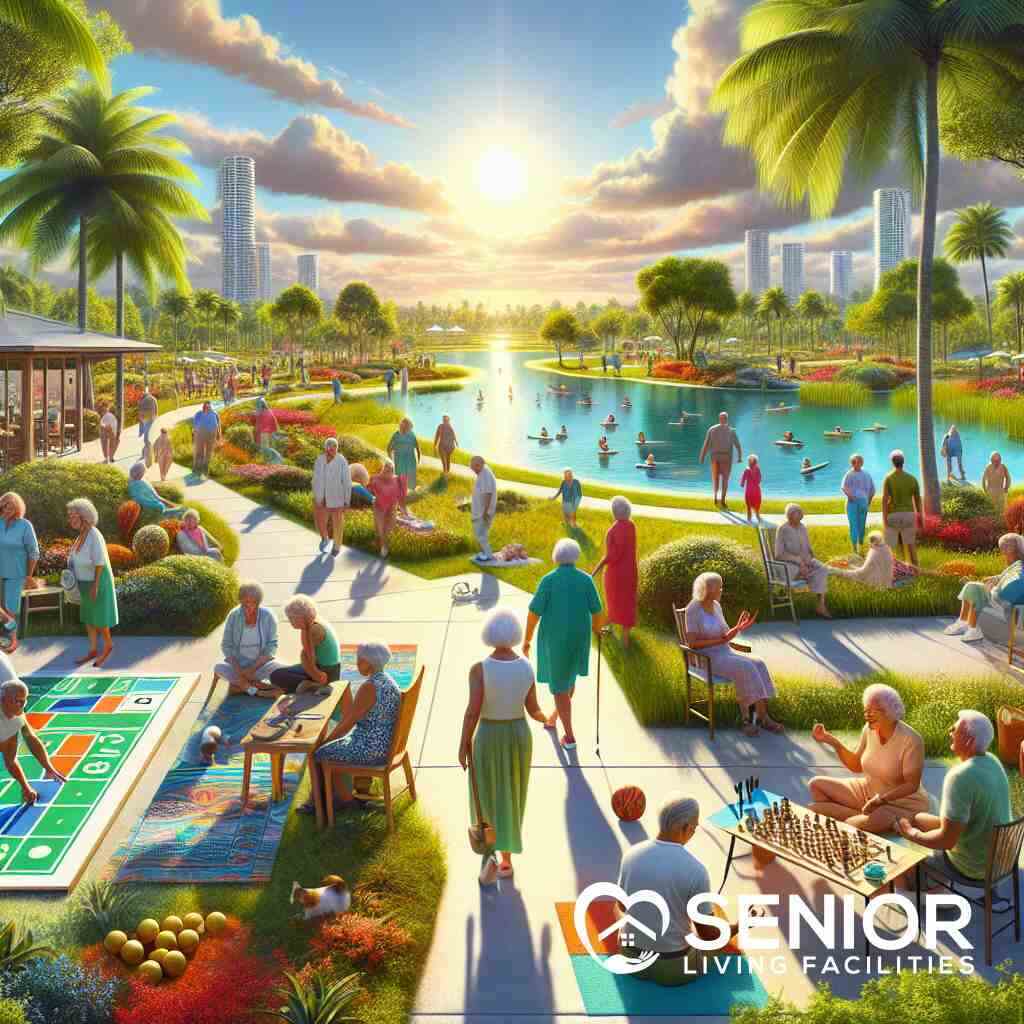
How Technology is Transforming Senior Living Facilities
April 8, 2025
Unveiling the Digital Dawn
The Rise of Tech-Enabled Senior Living
The landscape of senior living facilities is rapidly evolving, thanks in large part to the integration of advanced technologies. Today, technologies such as the Internet of Things (IoT) and artificial intelligence are at the forefront of this digital transformation, ushering in an era where tech in senior care is not merely a luxury but a necessity. These innovations are crafting more personalized, efficient, and safe environments for older adults. For both residents and their families, this translates into a profound sense of comfort and assurance that transcends traditional care standards.
Senior living communities are increasingly embedding smart devices in their infrastructure, transforming homes into nurturing environments that adapt to the needs of the elderly. From monitoring to automation, tech-enabled facilities promise improved care quality, bolstering seniors’ overall wellness and independence. As a result, seniors enjoy enriched lifestyles facilitated by unprecedented autonomy and a robust sense of belonging.
Navigating the Digital Health Revolution
A revolution is indeed underway in the realm of digital health for seniors. Technologies empowering this revolution range from telemedicine platforms that bring healthcare rights to residents’ living rooms to digital health monitoring tech for seniors that ensures proactive medical attention when needed. The digital landscape allows for seamless communication between providers and patients, thereby ensuring that the intricacies of seniors’ health requirements are promptly addressed.
Moreover, senior living facilities are investing in innovative telehealth solutions to provide continuous care without the logistical burdens of physical appointments. Wearable technology plays a pivotal role here, constantly assessing and reporting key health metrics. These digital health solutions empower older adults by improving their autonomy and simultaneously easing caregivers’ workloads, creating a balanced ecosystem within these communities.
Redefining Senior Communities tThroughInnovation
Innovation within senior communities is redefining the paradigms of elder care. Through innovative senior living solutions, powerful shifts are observed in how communities structure social interactions and healthcare services. These solutions promote a vibrant and interconnected community, fostering social engagement through digital platforms to combat isolation, a common challenge in senior settings.
The integration of virtual reality in senior communities stands out as a significant innovation, opening doors to new worlds of social and cognitive engagement. This technology transcends geographical barriers, allowing seniors to experience new cultures, connect with family members far away, and even participate in guided physical activities. By intertwining tech with care, these facilities are not only enhancing the quality of life but also revolutionizing the traditional notions of what senior living can be.
Elevating Care through Technology
AI and Personalized Care for Seniors
Artificial intelligence is redefining the future of senior care, enhancing the way personalized care is delivered to the elderly. In modern senior living facilities, AI-driven elder care provides a nuanced approach to understanding each resident’s unique health needs. This technology enables more accurate predictions and tailored interventions, significantly improving the quality of life for seniors. By analyzing data ranging from health records to daily activity patterns, AI systems can identify potential health issues before they escalate, offering proactive health solutions and peace of mind How Senior Living Facilities Foster Community Wellness?.
Furthermore, AI technology facilitates advanced planning for individualized care plans, ensuring that every senior receives the most beneficial interventions. This shift towards personalized care through technology for the elderly showcases the profound impact AI can have in creating a supportive and responsive living environment. The integration of AI into routine care processes not only lightens the caregivers’ workload but also enhances the efficiency and efficacy of the care delivered.
Telemedicine: Bringing Doctor’s Visits to the Living Room
Telemedicine is transforming how healthcare is accessed in senior living facilities, bringing medical consultations directly into the seniors’ living rooms. This innovative approach to healthcare delivery alleviates the need for time-consuming and often physically demanding trips to the doctor’s office, thus offering a convenient and efficient alternative. With telemedicine opportunities for the elderly, seniors have the chance to communicate with healthcare professionals via secure video conferencing, receiving immediate advice and support without leaving their residences.
Incorporating telemedicine into the fabric of senior care supports continuous monitoring and rapid response to health concerns as they arise. This ensures that seniors’ health needs are frequently reassessed and addressed in real-time, promoting better long-term health outcomes. The convenience of telemedicine enhances residents’ autonomy, empowering them to take an active role in managing their health while also improving access to a broader range of healthcare services.
Remote Monitoring and Smart Homes for Elderly Residents
The advent of remote monitoring systems and senior smart homes is revolutionizing the landscape of safety and autonomy for elderly residents. Smart technologies allow caregivers to monitor seniors’ health indicators and living settings without being intrusive, providing real-time updates and alerts should any anomalies arise. These systems enable enhanced independence for seniors, fostering a sense of freedom while maintaining a crucial safety net.
Smart homes for the elderly are equipped to adapt to the individual needs of their inhabitants, optimizing comfort and security around the clock. For instance, IoT applications in senior housing, such as smart lighting and voice-controlled assistants, simplify daily tasks and ensure the environment automatically responds to residents’ needs. This home automation for seniors not only promotes a higher standard of living but also supports sustained independent living by mitigating common risk factors associated with old age, such as falls and medical emergencies.
Fostering Connection and Engagement
The Role of Virtual Reality in Seniors’ Social Life
Virtual reality is revolutionizing the way seniors engage socially, enabling immersive experiences that transcend traditional barriers. This technology offers seniors the opportunity to visit distant lands or revisit cherished places from their past, all from the comfort of their communities, for seniors 55+. By providing these virtual experiences, seniors are better able to maintain a sense of wonder and excitement in their lives, counteracting the monotony that can occasionally accompany elder living.
Beyond mere entertainment, virtual reality also supports cognitive and emotional engagement. Seniors can partake in virtual group activities, such as museum tours or concerts, alongside fellow residents, thereby fostering deeper connections. This integration of immersive tech into social life within senior living facilities is not only about innovation but also about nurturing vibrant, community-focused relationships. Consequently, seniors experience enriched social lives marked by increased interaction and reduced isolation.
As technology becomes more ingrained in senior living, imaginative solutions like virtual reality offer significant benefits. Pairing cutting-edge tech with everyday social activities not only enhances the quality of life but also transforms perceptions of aging. As such, virtual reality underscores how innovative senior living solutions can bridge gaps, creating more fulfilling lives for seniors across communities.
Wearable Tech: Bridging Physical Health and Social Connectivity
Wearable technology is playing an important role in linking physical health with social connectivity in senior living. By tracking health metrics through wearable devices, seniors gain valuable insights into their well-being while staying connected with healthcare providers and families. These devices, such as smartwatches and fitness trackers, enable real-time monitoring, ensuring that health concerns are swiftly addressed.
Socially, wearables inspire active living by connecting seniors with peers through health-focused community challenges. For instance, step contests or collaborative fitness goals encourage seniors to stay active while fostering camaraderie among participants. Such tech-enabled activities support not just physical health but also nurture social bonds withisenior living community, which is crucialcial for a holistic approach to elder care.
Moreover, wearable technology includes devices designed to facilitate emergency communication, such as alert systems that notify caregivers in case of an incident. This aspect of wearable devices for elderly health promises peace of mind for seniors and their families, knowing help is just a button away. By intertwining technology with care, communities can ensure a balanced approach that addresses both physical health and social well-being.
Creating Connected Communities for Seniors
Creating connected senior communities is crucial for promoting engagement and enhancing quality of life. TIntegratingdigital platformallowws residents to effortlessly interact with peers, join social groups, and participate in community events. These platforms, often part of broader digital transformation in senior housing, serve as vital hubs for fostering social connections and engagement among residents.
The use of mobile apps aiding elderly care underpins this connectivity, enabling seamless coordination of activities and services. Residents can easily access event calendars, sign up for activities, and even communicate with staff or family members. This technological connectivity empowers seniors to have a say in their daily routines, reinforcing their autonomy and involvement in the community life of senior housing.
Furthermore, advanced connected senior communities utilize technology to combat social isolation, a prevalent issue in senior living. By encouraging digital interactions and facilitating in-person connections through technology, these communities create a supportive environment that celebrates collective experiences. This approach illustrates how senior living facilities are evolving, utilizing tech not only for care but also for community building, leading to enriched, more engaged living environments.
Innovations in Safety and Wellbeing
Enhancing Security Systems in Senior Housing
Incorporating innovations in senior living enhances the safety and overall well-being of elderly residents. State-of-the-art security systems in senior housing are no longer just about locks and alarms; they’re a blend of advanced technology and user-centric design. These systems include surveillance cameras with smart analytics, capable of identifying unusual activities and sending instant alerts to caregivers or family members. This proactive approach ensures that potential security threats are addressed promptly, providing a safer living environment for seniors.
Biometric access controls are another significant advancement in security systems for senior housing. These systems utilize fingerprint or facial recognition, ensuring that only authorized individuals gain entry. Through the integration of digital transformation in senior housing, facilities can increase both security and convenience for their residents. Moreover, such systems can be seamlessly integrated into the daily operations of senior living facilities, helping to reduce the risk of unauthorized access and ensuring peace of mind for residents and their families.
Voice-Activated Technology: Simplifying Daily Life
Voice-activated technology is simplifying daily life for seniors, transforming everyday tasks with just a verbal command. Devices such as smart speakers and virtual assistants have become invaluable tools in senior living, providing hands-free assistance for tasks like adjusting lighting, setting reminders, or making calls. This technology is particularly beneficial for seniors with mobility issues, enabling them to maintain control over their environment comfortably and safely.
By integrating voice-activated tech for the lderly, senior communities ccan significantly nhance the living eexperience This technology facilitates greater independence, reducing reliance on caregivers for simple daily activities. Furthermore, the ability to interact with tech through voice commands can boost confidence in using technology, fostering a sense of accomplishment and autonomy among seniors.
Importantly, voice-activated systems can also contribute to security and emergency response. Seniors can use their voice to alert staff or emergency services, ensuring rapid response in critical situations. As senior living facilities continue to embrace this technology, they pave the way for more personalized and efficient care environments.
Health Monitoring Devices: Empowering Elderly Independence
Health monitoring devices play a crucial role in empowering elderly independence within senior living facilities. These wearable technologies, such as smartwatches and medical alert devices, provide real-time data on vital signs such as heart rate, step count, and sleep patterns. With wearable devices for elderly health, seniors can monitor their health proactively, allowing for early detection and management of potential health issues.
The integration of monitoring devices into daily routines supports a preventive healthcare approach, emphasizing maintenance over crisis care. The Evolution of Healthcare Strategies in Senior Living Facilities. Caregivers and family members can receive alerts or regular updates, ensuring they are always informed about the health status of their elderly loved ones. This continuous stream of data allows for timely interventions, reducing hospital visits and enhancing overall quality of life.
Furthermore, these devices contribute to fostering emotional well-being by providing seniors with a sense of security and autonomy. Knowing that help is readily available if needed, seniors can engage more freely with community activities, improving both physical and social health. The ongoing advancements in health monitoring technology in senior living facilities promise a future of informed, independent, and healthier living for seniors.
Embracing the Future
The Path Forward: Tech-Enabled Senior Living Facilities
As we peer into the future of senior care, the role of technology becomes increasingly pivotal in shaping senior living facilities. These advancements promise not just incremental improvements but transformational shifts that redefine elderly living experiences. Focused on delivering personalized care through technology for elderly residents, these facilities are setting new benchmarks in elder care. By integrating diverse tech applications ranging from AI to telemedicine, senior living communities are poised to address the complex needs of their residents more efficiently and effectively.
Furthermore, technology fosters a more interconnected and informed community, significantly enhancing the quality of life. AI-driven elder care, for instance, is crucial in offering insights that are integral to understanding and catering to individual health needs. Through predictive analytics and personalized interventions, these technologies support a proactive, rather than reactive, approach to health and wellness. As a result, seniors benefit from enhanced care, autonomy, and engagement-transforming the very core of traditional elder care paradigms.
Moreover, the emphasis on senior smart homes reflects a commitment to creating nurturing and adaptive environments. These homes leverage IoT applications in senior housing to ensure safety and adaptability, facilitating independent living while being part of a connected senior community. As technology becomes more embedded in senior living, it paves the way for an era where innovation in care is seamlessly intertwined with comfort and convenience.
Crafting an Inspired Future for Senior Care
Crafting a future brimming with promise for senior care involves harnessing technology not just as a tool but as an integral component of everyday life in senior living facilities. By embracing robotics innovations in elder living, these communities can offer more personalized and efficient care solutions. Robots assist in various tasks, from companionship to physical therapy, enhancing the living experience while alleviating caregiver strain. This transformative approach signifies a new dawn where senior care is characterized by empowerment, dignity, and enhanced quality.
In addition, mobile apps aiding elderly care are revolutionary in connecting seniors with their families and caregivers, promoting consistent communication and engagement. These digital platforms ensure that all aspects of care, from medication management to social participation, are seamlessly coordinated, ensuring holistic well-being. This digital transformation in senior housing illustrates how the strategic use of technology can open doors to enriched living environments, fostering a sense of belonging and purpose in senior communities.
Finally, envisioning a tech-enabled future for senior living facilities means creating an environment where each resident’s needs and preferences are met with precision and empathy. Through the continued evolution of tech-assisted living solutions, these communities can offer support that not only meets but anticipates seniors’ evolving needs. By shaping an inspired future where innovation meets compassion, the senior living sector can cultivate environments that celebrate life, ensuring that every senior has access to a dignified and fulfilling living experience.
Frequently Asked Questions
Question: How is technology improving personalized care for seniors in facilities recommended by Senior Living Facilities?
Answer: Technology is significantly enhancing personalized care for seniors by integrating advanced solutions like AI and IoT in elder care environments. At Senior Living Facilities, our recommended communities utilize AI-driven solutions to tailor care plans uniquely suited to each resident’s health needs. By analyzing health records and daily activity patterns, these solutions provide insights that enable proactive health interventions, preventing potential issues before they arise. This personalized care through technology not only improves the quality of life but also ensures each senior receives care that respects their individual needs and preferences, making senior living both safe and fulfilling.
Question: In the blog post How Technology is Transforming Senior Living Facilities, how does telemedicine contribute to better healthcare access for seniors?
Answer: Telemedicine plays a pivotal role in improving healthcare access for seniors, a focus highlighted in our blog How Technology is Transforming Senior Living Facilities. By facilitating direct video consultations with healthcare professionals, telemedicine eliminates the need for time-consuming and physically taxing trips to medical offices. Our partnered communities with Senior Living Facilities incorporate telemedicine to ensure residents have immediate access to medical advice from the comfort of their living rooms. This convenience not only supports continuous health monitoring but also encourages seniors to actively participate in managing their health, contributing to improved long-term health outcomes and greater autonomy.
Question: How do smart homes and remote monitoring technologies enhance the safety and independence of elderly residents in senior living communities?
Answer: Smart homes and remote monitoring technologies are revolutionizing safety and autonomy in senior living communities recommended by Senior Living Facilities. These tech-enabled homes are equipped with smart devices like lighting controls and voice assistants that adjust to the individual needs of seniors, ensuring comfort while minimizing risks. Remote monitoring systems provide real-time health updates and alerts, offering a crucial safety net without being intrusive. This integration helps maintain an independent lifestyle for seniors while ensuring caregivers are notified immediately in case of any health anomalies, thus enhancing overall well-being and peace of mind for both residents and their families.
Question: What innovative senior tech solutions are being implemented to foster social connectivity and engagement among residents in communities for seniors 55+?
Answer: Innovative senior tech solutions such as wearable technology and virtual reality are key in fostering social connectivity and engagement among residents in communities for seniors 55+. Facilities recommended by Senior Living Facilities leverage these technologies to enrich residents’ social lives. Wearables encourage physical activity through community health challenges, while virtual reality offers immersive experiences like museum tours and concerts that bring residents together for shared activities. By nurturing social bonds through these engaging technologies, senior communities not only combat isolation but also create vibrant, interconnected environments where seniors can thrive both physically and socially.
Question: How do enhanced security systems in senior housing facilities recommended by Senior Living Facilities ensure residents’ safety?
Answer: Enhanced security systems in senior housing facilities, as recommended by Senior Living Facilities, are designed to provide comprehensive safety measures for residents. These include biometric access controls and surveillance systems with smart analytics capable of detecting unusual activities and instantly alerting caregivers. By utilizing these advanced security technologies, facilities ensure only authorized access, reducing risks and providing peace of mind. This proactive approach to security is integral to creating a secure and stress-free living environment where seniors can enjoy their independence without compromising their safety.




